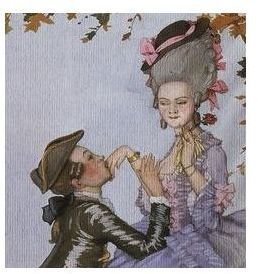Flirting Gestures in Different Cultures: Be Sure what You Do Means What you Want It to Mean!
Covert Glances and Eye Contact
Shooting frequent sideways glances from beneath the lashes, seeking open eye contact or even winking are all common flirting gestures in the U.S. The flirtatious meaning of eye contact is even more pronounced in Europe, where it is a sign of open admiration.
The same behavior, however, could land you in hot water in Muslim countries. Eye contact, except the most fleeting, is not allowed between men and women in Arabic countries for religious reasons. The gesture is considered as “adultery of the eyes” and can have dire consequences for foreigners, who in the worst of cases might get themselves arrested. That does not mean that Arab men will not stare at a Western woman, but if she returns the glance, thinking that she is only flirting, she could be in for an unpleasant surprise. Glancing back means that she is sexually interested in the man in question and could be construed as an open invitation to have sex. She might be considered a prostitute and be treated as such.
Chinese and Japanese women will not initiate eye contact either. It is considered rude and a sign of disrespect and the same applies to a man seeking prolonged eye contact. In Latin America, steady eye contact is not a sign of openness and trust, but often indicates aggression and a challenge. Men’s ogling of a woman, often accompanied with “piropos” like “guapa” do not mean flirtation with a particular woman either, but are a general expression of admiration for the female sex.
Spanish women, on the other hand, may still be guided by some atavistic rules of eye contact and flirtatious glances. These rules stem from the centuries old “language of the fan”. Given the fact that historically Spanish girls were very protected and not allowed open contact, the fan was used as a coy way to convey a message to a man, rather than as a cooling device. Fanning oneself vigorously means “I’m in love with you,” closing the fan slowly means “yes,” moving the fingers along the ribs means “I’m interested in you and want to talk to you.” Even nowadays, you will rarely see a Spanish woman or girl without a fan in the summer and some may still remember how to use the fan language.
Hand Kisses

Kissing a woman’s hand is very much a European habit and has recently seen a revival in Germany and Austria. Neither Englishmen nor Americans know much about hand kissing, let alone how to do it properly. A hand kiss, which involves only one hand each and no touching of the skin by the lips at all, is a sign of respect when a man greets a woman. However, the greeting beomes flirting, when the man grabs the woman’s hand with both his hands, squeezes, plants a kiss on the back of the hand and accompanies the entire ceremony with an open or seductive glance.
Trying to kiss or even shake a woman’s hand in Arabic cultures is an absolute no-no. Islam forbids any bodily contact between the sexes, other than husband and wife or close family. In Turkey an exception might be, you could possibly kiss the hand of a much older woman as a sign of respect.
Cheek Kissing and Touching

In the United States, flirting gestures are usually restricted to glances, fiddling with earrings and flicking or straightening the hair. Kisses, even on the cheek, and touching come later after the initial contact has been made and both partners have expressed their mutual attraction and wish to know each other further.
Kissing the cheek, once or several times, is a common greeting ritual in Spain and Latin American countries. The kiss is often accompanied by touching the arm or shoulder, but it is not a sign of flirtation. Latin people are just much more physical than Americans.
Such kissing and touching is, again, totally forbidden in Muslim countries and equally inappropriate in many Asian countries. In India, Thailand and Japan for instance, bowing substitutes for the handshake and cheek kissing.
Generally speaking, what is flirting and harmless in one country can be offensive in another, so it is wise to study the rules of cultural behavior before setting off on a trip to foreign countries.
References
Boston University School of Medicine: https://www.bu.edu/bhlp/Resources/Islam/health/guidelines.html
“The Status of Woman in Islam”: https://www.unh.edu/msa/w-status.htm
“Fan: Cultural Significance”; Mercyhurst College; https://plato.mercyhurst.edu/english/breed/www/Blazon/fan.htm
“Non Verbal Communication Modes”; Andrews University; https://www.andrews.edu/~tidwell/bsad560/NonVerbal.html
Image Credits
Flirting Image: Manoel Lopes Rodrigues/Public Domain/commons.wikimedia.org/wiki/File:Manoel_Lopes_Rodrigues_-_Rosto_de_Espanhola_com_Leque.jpg
Kiss on the Hand Image: Иллюстрация к “Книге маркизы”. Дама и кавалер XVIII века/Public Domain/commons.wikimedia.org/wiki/File:Сомов01.jpg
Kiss on the Cheek Image: Jean Honore Fragonard/Public Domain/commons.wikimedia.org/wiki/File:Сомов01.jpg
